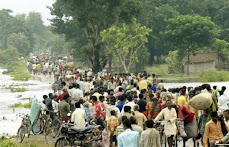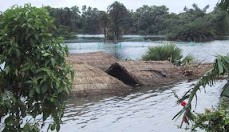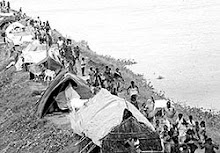Embankments cause devastation, disaster, catastrophe and migration from Bihar. Parliament is being misled by these ideas of embankments suggested by the ministry of water resources, which is as good as jumping from the frying pan into the fire.
UNION MINISTRY of water resources misled the Rajya Sabha on March 11, 2008 on the issue of ‘Floods in North Bihar’ that ensures a status quo of misery in the region. In a Press Information Bureau release, it claimed, “Government has taken various steps in the direction of water management to stop the flood in North Bihar coming from the rivers of Nepal. To control the floods in rivers Baghmati and Kamala-Balan in North Bihar, the government has approved two schemes, namely, (i) Raising and strengthening of embankments along River Baghmati at an estimated cost of Rs 135.16 crores and (ii) Raising and strengthening of embankments along River Kamala at an estimated cost of Rs 52.09 crores.”
What it means to raise and strengthen the embankments has come to light from the preliminary findings of the multidisciplinary 14-member fact-finding team that toured from March 1-8, 2008, the flood affected regions of North Bihar wherein it traversed along the embanked parts of Kosi, Kamala, Bhutahi Balan and Baghmati rivers. The team noted, “The manner in which floods have been amazingly sustained in this region despite over five decades of relentless efforts.”
The current proposals illustrates that the embankment lobby has gained momentum once again, the fact that such interventions will raise river levels by several metres, making the land between the embankments uninhabitable for millions of people, displacing them for good. The bitter experience of flood control embankments has given birth to a strong sentiment against it.
Now it is a common knowledge and the narratives of the villagers corroborate that embankments are for the benefit of the contractor politicians and the technocratic development ideology to deal with flood suits them unmindful of the environmental and social mess. The statistics also show that 8.36 lakh hectares of land in North Bihar is permanently waterlogged, which is nearly 16 per cent of North Bihar’s total area, earning the state the dubious distinction of being the leading claimant of this kind of manmade submergence.
It concluded that “not only are these floods man made but that the worse is yet to come should the political economy of flood control continue to pivot itself around ‘temporary embankment’ as the only solution to the scourge of floods. The state pretends that it is afflicted by the colossal ignorance regarding the primary function of floodwater – draining out excess water and the fact that no embankment has yet been built or can be built in future that will not breach.” The team found, “The government’s investment of over Rs 1600 crores since the early 1950s has helped increase the flood prone area from 25 lakh hectares during the pre-plan era to over 68.8 lakh hectares today, an unprecedented three-fold increase. Proposed as temporary measure to control floods in the 1950s and having had failed on all fronts, the team is bewildered to note that the business of embankment construction has resumed after a lapse of 17 years with a Rs 792 crores package to tame the Baghmati. There is another proposal to embank the tributaries of Mahananda at an estimated cost of Rs 850 crores. Clearly, the lessons in human misery have not been learnt.”
The ministry is taking the parliament for ride by stating, “Government of India has initiated steps for creation of storages in the Nepal territory, which will help in mitigating the problem of floods being faced in North Bihar.” The fact is that the negotiation that has been going on since 1947 between India and Nepal on creation of storages remains inconclusive. It has been said time and again that the government would negotiate with Nepal to construct a dam over Kosi River.
The ministry claims, “A detailed project report for the Sapt Kosi High Dam project and Sun Kosi diversion scheme is under preparation jointly with the cooperation of the government of Nepal. The steps that are being claimed to have been initiated, are as old as 60 years but they remain where they were in 1945. A joint Indo-Nepal team of experts has been engaged in a field study of the proposed Kosi High Dam, which was first mooted in 1947. The matter relating to construction of dam over Kosi River is an international matter. The construction of this dam is possible only when there would be an agreement between Nepal and India. The negotiations have been going on for a long time but we could not reach at any agreement till now.”
The ministry informed the parliament, “The central government has envisaged to make a comprehensive assessment of the feasibility of linking the rivers in the country starting with the Southern rivers in a fully consultative manner. It would also explore the feasibility of linking sub-basins of rivers within the states, like Bihar. Six intra-state link proposals have been identified in Bihar by the state government of Bihar, namely, (i) Kohra-Chandravat, (ii) Burhi-Gandak-None-Baya-Ganga, (iii) Bagmati-Burhi-Gandak through Belwabhar, (iv) Kosi-Ganga, (v) Kosi-Mechi (Indian portion) and (vi) Karmanasha-Suara links in Bihar. The state government of Bihar has commenced the study of these intra-state links.” Interlinking of rivers is suggested for flood proofing among other things. A ‘Report of the Expert Committee’ to study impact of interlinking of rivers on Bihar (April 2005, Chapter III, p16) says, “…But the proposed Sapt Kosi Dam too has not been provided with any flood cushion which should be provided for flood moderation…”
The ministry pretends that the Bihar project has no relation with the proposed national interlinking of rivers projects. After compounding the misery of North Bihar through embankments, those living today in the flood-affected region are being promised other ecologically disastrous projects like Barahkshethra Dam and interlinking of rivers is like proposing one catastrophe to solve another.
It is high time the ministry of water resources learnt from its blunders in Kosi. Unlike what is being promoted by the government. “The only solution is to do away with the embankments and allow the river to go ahead with its natural land-building process,” says Dr Dinesh Kumar Mishra, convener, Barh Mukti Andolan and a member of the fact-finding team.
For details contact:
Dr Dinesh Kumar Mishra,
Tel: 0919431303360
E-mail: dineshkmishra@rediffmail.com
Dr Sudhirendar Sharma,
Tel: 9868384744
E-mail: sudhirendar@vsnl.net
Gopal Krishna,
Tel: 9818089660
E-mail: krishnagreen@gmail.com
Source: www.merinews.com/catFull.jsp?articleID=131065
Historically, floods and their control have never been a big issue in the Ganga-Brahmaputra basin, as it is today. Floods became a major issue after the British occupied India. When they examined the Ganga basin, they believed that if it could be made “flood-free”, they could levy a tax in return for such protection.
Sunday, 16 March 2008
Subscribe to:
Post Comments (Atom)








No comments:
Post a Comment